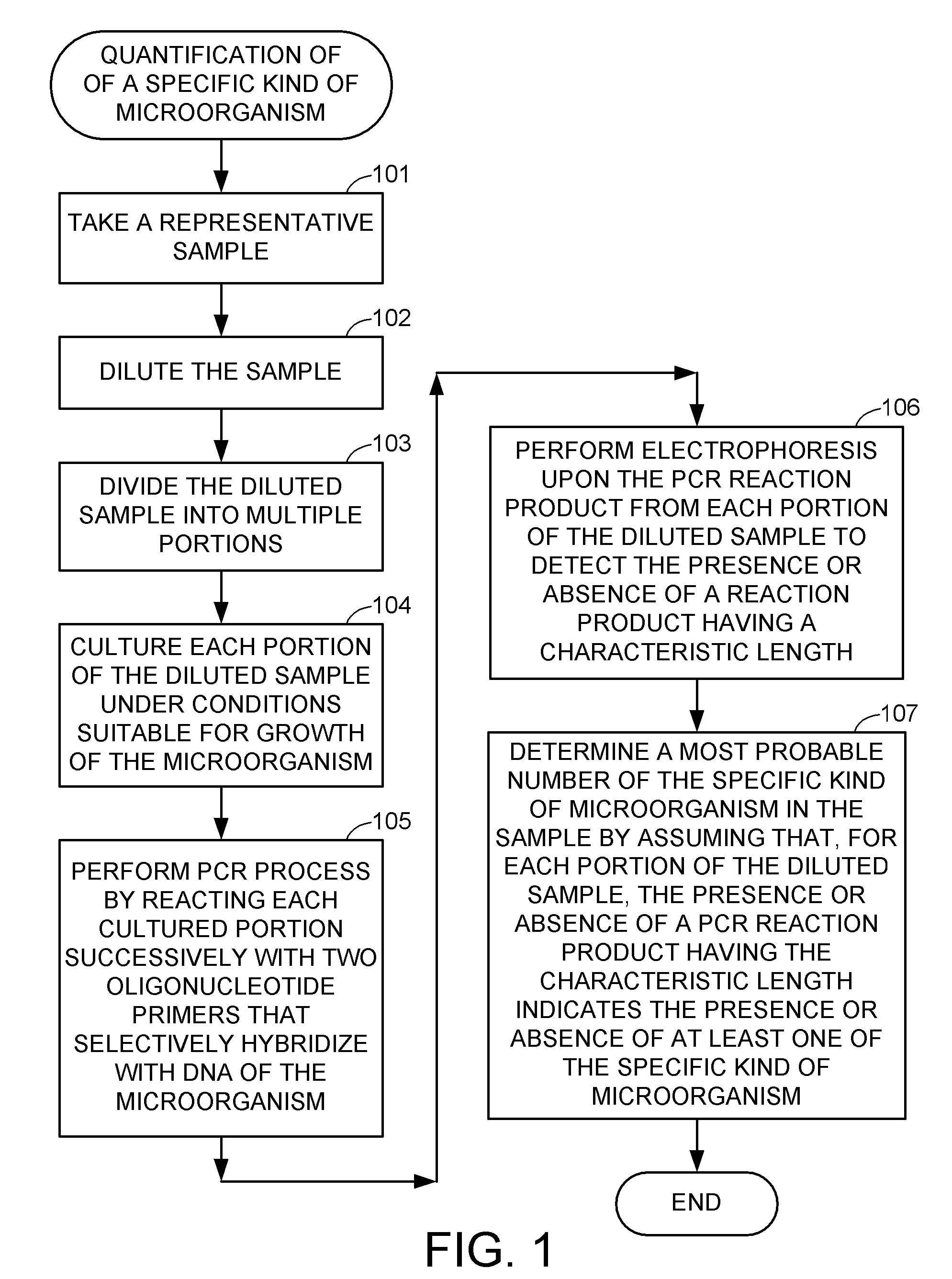Methods for detecting and quantifying specific microorganisms
a technology for specific microorganisms and detection methods, applied in the field of detection and quantification of specific microorganisms, can solve the problems of complicated identification and quantification, often compromised methods,
- Summary
- Abstract
- Description
- Claims
- Application Information
AI Technical Summary
Benefits of technology
Problems solved by technology
Method used
Image
Examples
example 1
[0026] Sampling of Animal Feed
[0027] An important first step in an analysis of animal feed is the obtaining of representative samples. While many suitable methods may be designed, the following has been found to be effective.
[0028] Ten samples of about 500 grams each are obtained. The samples are placed in sterile plastic bags, and are sealed. The bags are marked regarding the date and time that the sample was taken, and the amount of probiotic added to the animal feed (typically per ton of feed). Samples are obtained randomly, and from materials dispersed within the feed. For example, a 10,000 pound load of feed can be sampled once every 1,000 pounds for a total of 10 samples. If the probiotic is known or suspected of being sensitive to light, heat, or air, then the samples should be obtained from the “inside” of the feed pile.
[0029] The same number of control samples can be taken from the same type of feed that was not treated with the probiotic. The control samples are useful ...
example 2
[0031] Media
[0032] Liquid or solid media should be selected to be suitable for growth of the probiotic. For example, when assaying for the probiotic Lactobacillus LA51, LBS broth and LBS agar can be used according to the manufacturer's protocols. LBS is commercially available from a wide array of suppliers including Sigma-Aldrich (St. Louis, Mo.) and Alpha Biosciences (Baltimore, Md.). LBS obtained from Alpha Biosciences has a pH of 5.5±0.2 at 25° C. and contains the following components: casein digest peptone (10.0 g / l), dextrose (20.0 g / l), yeast extract (5.0 g / l), sodium acetate (25.0 g / l), monopotassium phosphate (6.0 g / l), Tween 80 (1.0 g / l), ferrous sulfate (0.034 g / l), ammonium citrate (2.0 g / l), magnesium sulfate (0.575 g / l), manganese sulfate (0.12 g / l), and agar (for solid media, 15.0 g / l).
example 3
[0033] LBS Plating of Probiotics
[0034] Ten grams of sample is added to 90 ml of 0.1% peptone in distilled water. The mixture is shaken in a mixing cylinder 30 times. The mixture is allowed to stand for 10 minutes. This is the −1 dilution.
[0035] Multiple additional serial dilutions are performed as needed to provide a reasonable number of colonies growing on an LBS plate to count. For example, dilutions of −1, −2, −3, −4, −5, and −6 can be made. Depending on the size of the plate used, a small volume of the dilution is spread evenly across the surface of the plate for culturing. Typically, 0.1 to 1 ml of liquid is used. Plates can be prepared singly or in replicates for enumeration.
[0036] Plates are covered, and incubated in an anaerobic environment for 48 hours at 35° C. The counts on the plates are determined. Typically, between 30 and 300 counts per plate is reasonable. Multiple colonies from the plate can be examined microscopically. Typically about five colonies per plate are...
PUM
| Property | Measurement | Unit |
|---|---|---|
| Length | aaaaa | aaaaa |
Abstract
Description
Claims
Application Information
 Login to View More
Login to View More - R&D
- Intellectual Property
- Life Sciences
- Materials
- Tech Scout
- Unparalleled Data Quality
- Higher Quality Content
- 60% Fewer Hallucinations
Browse by: Latest US Patents, China's latest patents, Technical Efficacy Thesaurus, Application Domain, Technology Topic, Popular Technical Reports.
© 2025 PatSnap. All rights reserved.Legal|Privacy policy|Modern Slavery Act Transparency Statement|Sitemap|About US| Contact US: help@patsnap.com

